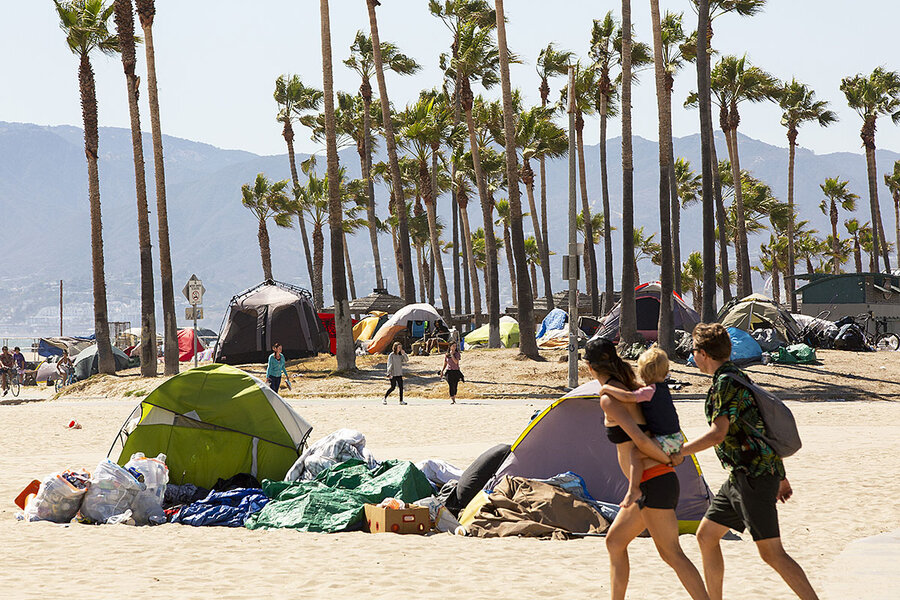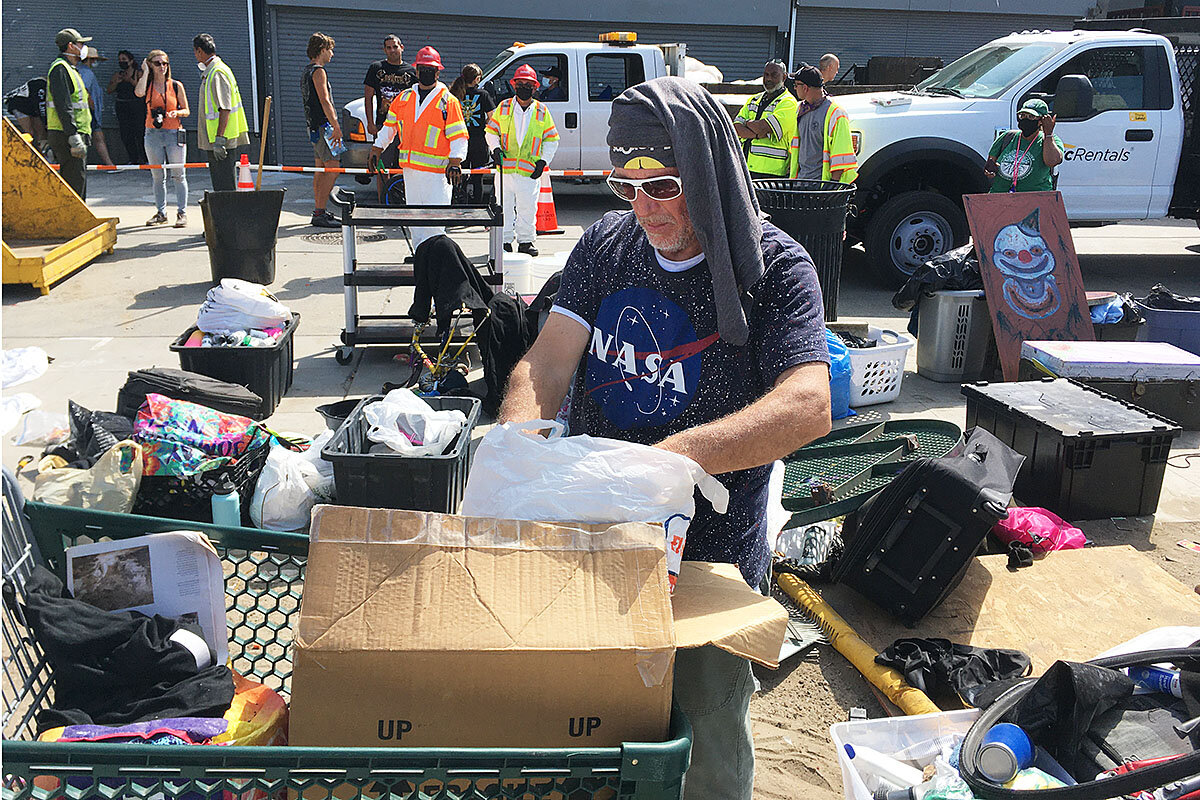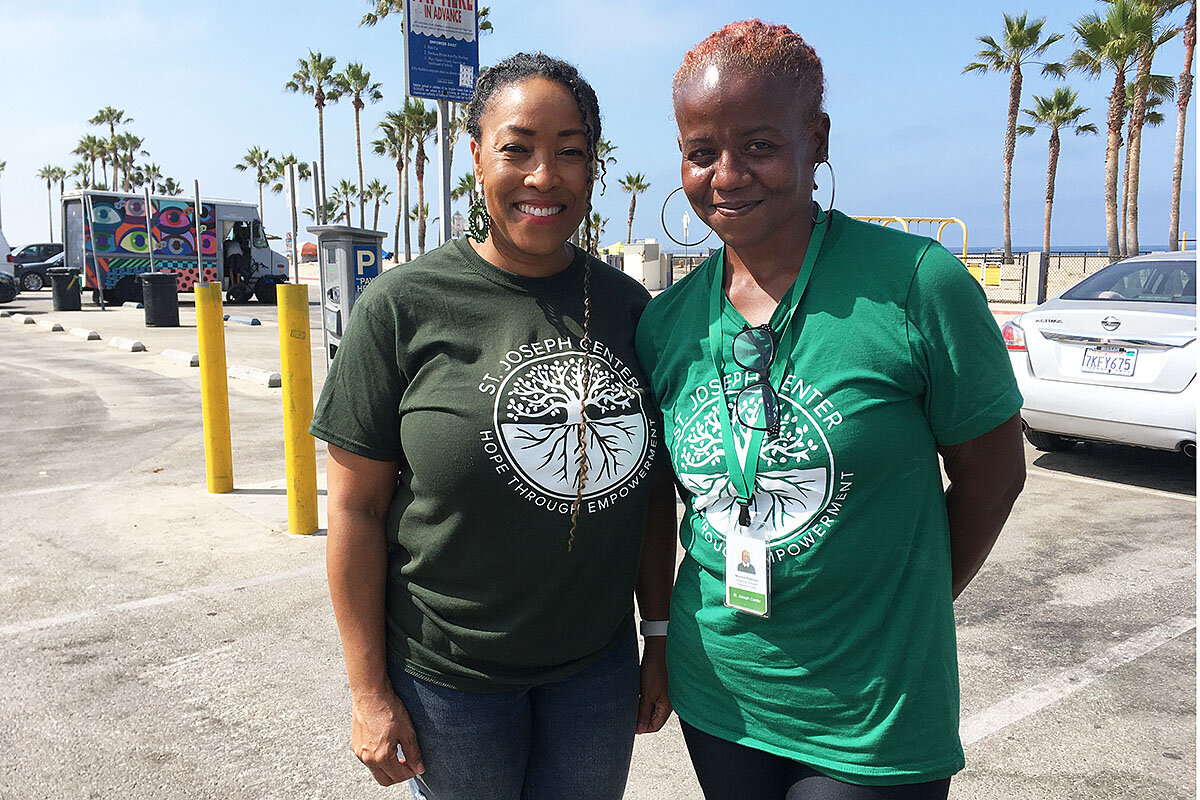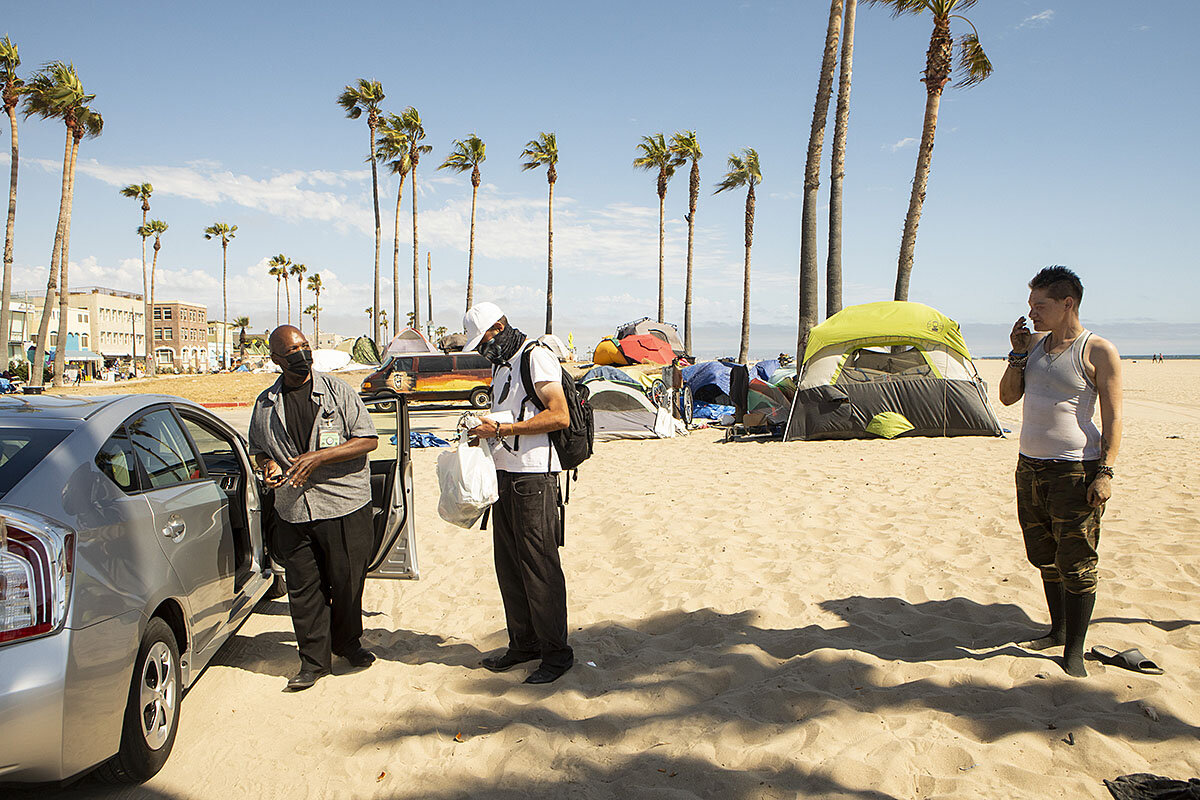Cities grapple with homelessness, as tent clusters proliferate
Loading...
| Los Angeles
It is nearly noon, and a Los Angeles sanitation crew is wrapping up dismantling the home of Jack Rivers.
A yellow-vested worker rakes the narrow strip of dirt where the veteran’s tarp-covered dwelling once stood – part of a highly controversial homeless encampment of about 200 people jammed along the iconic boardwalk at Venice Beach.
All morning, Mr. Rivers has been sorting his mounds of belongings, his head wrapped in a T-shirt to protect him from the sun. With a small crowd looking on, he flings a sweatshirt, pants, rolls of toilet paper, and a flurry of blue face masks toward a shopping cart. He rolls a round tabletop out of his way and heaves a bicycle frame.
Why We Wrote This
The pandemic drove more homeless people into tents, and emergency public health measures allowed many to remain undisturbed. Now, localities are trying to find better housing and care solutions.
The sanitation workers have already tossed carpets, a nylon awning, and boards into the maw of a nearby garbage truck. They use grabbers to pick up hazardous waste such as needles. From time to time, a mouse or rat makes a quick getaway as items are moved.
This is a voluntary clearing – an exercise in patience that some describe as a more humane approach than a one-time sweep by law enforcement.
Clearing the entire encampment was slated to be done over six weeks, finishing by the end of July. It has taken hours to tackle just this one site, as outreach workers allow Mr. Rivers to decide which of his possessions to keep for up to 90 days in storage. And it has taken months of visits to persuade the native Angeleno, who cited his battles with illness and substance abuse, to move to temporary housing under Project Roomkey, a state and local effort to secure hotel and motel rooms for homeless people during the pandemic.
“I feel very blessed to be there,” he says of his room at the Cadillac Hotel, a pink oceanfront property just half a block down the boardwalk.
There’s no hard data, but experts and advocates agree that encampments like this one have grown in size and number in cities across the United States. The COVID-19 pandemic forced shelters to reduce occupancy, and while thousands of unhoused people were moved into hotels and motels, many others lost homes and were simply displaced.
To prevent viral spread, the Centers for Disease Control and Prevention recommended against breaking up the tent clusters. The pandemic also exacerbated mental health and drug and alcohol issues, while treatment stopped.
The growth of urban encampments has led to clashes over the use of public spaces like parks and sidewalks. In Washington, D.C., where tents have mushroomed over the last 18 months, controversy erupted over a plan to replace a minicamp at trendy Dupont Circle with cafe tables and chairs. The city decided to do a cleaning, not a clearing.
In Seattle, where the city all but halted tent removals during the pandemic, the number of tents has increased by more than 50% in its urban core since before the pandemic, and greatly expanded in areas where they’d previously had little presence. Several jurors have refused to serve in the county superior court because of violence, including a fatal stabbing, at the encampment next door in City Hall Park. A county councilman is trying to force a change in jurisdiction of the park in order to relocate tent dwellers to transitional or permanent housing.
Pressure is ramping up on local politicians to “do something,” while raising questions about the best approach. A first-of-its-kind study of encampments, published in January 2020, found that cities have a “weak knowledge base” of what to do about this issue.
Researchers looked at four cities – Chicago; Houston; San Jose, California; and Tacoma, Washington – and found that they coalesced around a general strategy of “clearance and closure with support.”
It’s an approach that appears to be gaining ground – but it’s expensive, with the cost per homeless person ranging from $1,672 in San Jose to $6,208 in Tacoma, the greatest cost being for outreach. None of the cities has the ability to shelter its entire homeless population, and a common problem with clearing encampments is that it can end up simply reshuffling people and tents and re-traumatizing those being moved.
In California, a growing problem
There are now more homeless people living outdoors in America than sheltered, and no state has more than California, which counts 113,660 people, or 70% of its homeless population, as unsheltered. The Golden State has struggled for years with homelessness, but the explosion in tent communities during the pandemic is forcing cities here to try different approaches.
San Francisco created “safe sleeping villages” during the pandemic, providing security, meals, running water, and trash pickup for tent communities – which cost the city $5,000 per camper per month. Sacramento Mayor Darrell Steinberg is proposing a “right to housing” mandate that would force his city to provide choices of housing or shelter beds for homeless people, which they must take or face an undetermined civil penalty.
This month, the Los Angeles City Council voted overwhelmingly to enact rules prohibiting sitting, sleeping, or storing belongings near homeless shelters, schools, parks, and other types of public areas, or the person must pay a fine – which some consider an unfair punishment that most homeless people would be unable to pay anyway. It’s unclear how such an ordinance squares with a 2018 appeals court ruling, upheld by the U.S. Supreme Court, which struck down anti-camping laws as cruel and unusual punishment if shelter is not available.
Still, unquestionably the pressure is rising on politicians. California Gov. Gavin Newsom is facing a recall election in September in which homelessness is a major complaint. And here on Ocean Front Walk in Venice, where a man was killed in a tent last month and where drug and alcohol abuse is rampant, a petition drive is underway to recall a city councilmember, Mike Bonin, over homelessness and crime.
Notably, neighboring Santa Monica, which enforces its regulations about no overnighting on the beach, has no beach encampments.
“We have a real state of emergency here,” says Kayde McMullen, manager of the Venice Ale House. Tourism is down and repeat customers are staying away, says Mr. McMullen, who is harshly critical of Councilmember Bonin. The manager tells of one person who ran into the Ale House bathroom, locked the door, and started screaming; another was found shooting up in the bathroom. While Venice had homelessness before COVID-19, “the pandemic blew the cap off,” he says from behind a wooden counter.
In June, Mr. Bonin – himself once homeless – announced in a letter to constituents an “unprecedented” six-week program to “humanely” address the encampment crisis and offer interim housing and support services leading to permanent housing. It is a coordinated effort between neighbors, government agencies, and nonprofits, but – he pointedly said – “the effort will not be led by law enforcement, nor driven by threats of arrest or incarceration.” Law enforcement, however, has been involved in the clearing, mostly standing guard, but also rousting beach sleepers in the middle of the night.
In March, LA police cleared a large encampment at Echo Park Lake that turned into a confrontation as law enforcement arrested scores of people over two nights of protests. Most of the homeless people living there received interim housing, and most are still in it. The city restored the park’s lawns and facilities, and now it is surrounded by a temporary chain-link fence. Families tour the lake in swan paddle boats, while private security personnel regularly patrol in golf carts.
The importance of outreach
Fundamental to the clearing in Venice are outreach workers coordinated by the nonprofit St. Joseph Center and the Los Angeles Homeless Services Authority, which last month put out a “best practices” guide for dealing with street encampments. At the top of the list are allowing ample time to engage with homeless people and helping them voluntarily accept care.
The workers gather for morning briefings in a beach parking lot, then set out in small teams, clipboards in hand and backpacks filled with sandwiches, fruit, and bottled water. They approach tent dwellers far in advance of the clearing start date, and talk with them multiple times – asking what kind of housing they might accept, what income they might have, what services they need. Some of the workers have experienced trauma themselves, and can relate as peers.
“People are recognizing it does take time to build trust. That’s very positive,” says Gary Painter, director of the Homelessness Policy Research Institute at the University of Southern California in Los Angeles.
Monica Peterson, an outreach worker with St. Joseph, says workers “hit the pavement as early as 7 and we end when we end.” They are now experimenting with late-night outreach. She recalls a case that took more than a year of repeated engagement – a woman who had set up on Venice Beach, selling her art as a vendor. She didn’t want to leave until just recently, and finally accepted a Project Roomkey placement, also at the Cadillac Hotel.
“It really does take time for people who have had repeated disappointments, trauma, and losses,” explains Dr. Va Lecia Adams Kellum, president of St. Joseph. Outreach workers keep approaching unhoused people, she says, “because you never know when that moment is going to be where they go, ‘You know what, I think I do deserve to live a better life. I think I do deserve something better than this.’ And we’d want to be the ones to deliver on that.”
As of July 19, the workers brought 131 people from the Venice encampment into interim housing – more than halfway to their goal. They have connected more than 40 of them with permanent housing.
More resources, not enough housing
A big difference is that these workers currently have more resources to offer – federal reimbursement for Project Roomkey, and more federal rental voucher assistance and other help passed by Congress this year. Matthew Doherty, a former homelessness official with the Obama administration, calls it the greatest scale-up of federal support he’s ever seen addressing homelessness, though he adds that communities are “struggling to move those resources as quickly as they can.”
He also points to California’s budget surplus and the $12 billion slotted for homelessness, prevention, and affordable housing. “I’m really optimistic about the scale of resources in that budget.”
But Venice Beach is just one encampment in a city and county full of them. While more than 65,000 people have been brought into housing in the last several years, there still is not enough affordable housing. And the complexities of housing people with different histories and needs and conditions are visible right on the beach, where some experts estimate that 40% to 60% of homeless people are “service resistant.” Many just want the beach lifestyle.
One of them is Rob Nelson, who lost his house in Mount Shasta in the northern part of the state and came down to Venice about 18 months ago to escape the snow. On the day the clearing effort started, he was raking his little patch of sand on the northern end of the encampment, cleaning up around what he termed his “office” – a tarp-covered structure. He said he had no intention of accepting any offer for housing or services. He loves it on the beach. “I need to be an outdoor person at the moment.”
Two weeks later, he was still there, having whittled his things down to a suitcase, a backpack, and a sleeping pad. The outreach workers had been by many times – “yap, yap, yap.” He said he planned to head south to Ocean Beach in San Diego, but still had a few bulky items he was trying to get rid of.
“Do you have need of a five-gallon propane can?”
By yesterday, the area where Mr. Nelson slept was cleared. There was no sign of him, or his propane tank. Just people zipping along on bikes and skateboards, and a little bit beyond, about a dozen tents newly scattered over the bright, wide stretch of sand.
Staff writer Ann Scott Tyson contributed to this report.









